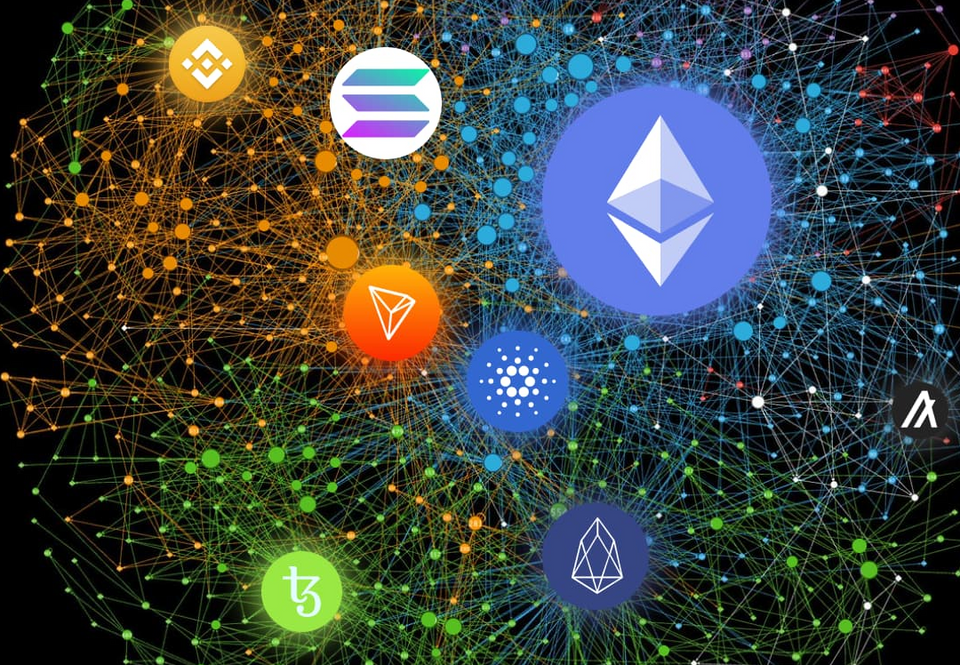The Ethereum Blockchain's Limitations
When a new technology is introduced, there is an explosion of new ideas as different groups try to improve the existing system. Within the blockchain ecosystem, there are several platforms for running smart contracts.
Consider a platform like an operating system, such as Android or iPhone, with smart contracts that are like phone apps. Each platform also includes a token that is used to pay for the system's costs, and the tokens may also be held for investment and speculative purposes.
What Is the Dominant Blockchain Platform, and What Are its Problems?
The Ethereum blockchain (ETH) is currently a dominant platform. However, the Ethereum blockchain has a number of drawbacks associated with it.
To begin with, Ethereum transactions are becoming increasingly costly. As the price of Ethereum increases, smart contracts which the Ethereum blockchain uses become cost-prohibitive. Second, Ethereum has a slow transaction speed, processing just a few dozen transactions per second.
Another issue with the Ethereum blockchain is that it employs the proof-of-work mechanism, which costs a vast amount of computational power to perform mining, resulting in environmental issues. Finally, Ethereum requires specialized programming languages less developed than the languages used outside the blockchain ecosystem.
Because of these concerns, Ethereum is changing its infrastructure to introduce Ethereum 2.0, which will enhance transaction speeds and employ a less computationally intensive system. The shift to Ethereum 2.0 might take several months, if not years. Meanwhile, other individuals have developed other platforms and ways to solve these challenges.
One critical issue with Ethereum is verifying the validity of a transaction using the proof-of-work system, where many computer systems keep rolling electronic dice until they find a magic value. The winner of the electronic lottery then decides which transactions are to be trusted.
However, the proof-of-work mechanism requires vast amounts of computer resources, and has been criticized for being terrible for the environment by wasting huge amounts of electricity. Therefore, alternative blockchains use a different mechanism, known as proof-of-stake.
Instead of miners, validators are used in the proof-of-stake. A validator who intends to validate the transactions puts up a deposit. The blockchain’s validity is based on the assumption that people willing to stake their coins can be trusted to judge which transactions are valid.
Another improvement is to set up the blockchain to use a different programming language such as Haskell, C++, or Rust, which is more mature and more standard than the language used in the Ethereum blockchain.
What Are Some Alternative Blockchain Platforms Currently in Use?
Several blockchain platforms that have been developed as alternatives to Ethereum are:
Binance Smart Chain (BSC)
Binance Smart Chain is a blockchain designed by the cryptocurrency exchange Binance. The unique feature of BSC is that it uses Ethereum compatible smart contracts, which makes it simple to migrate smart contracts from Ethereum onto BSC.
Rather than employing Ethereum's compute-intensive proof-of-work mechanism, BSC employs a proof-of-stake consensus approach, which allows for significantly cheaper and quicker transactions than Ethereum.
BSC depends on validators who stake Binance issued BNB tokens to decide whether a transaction is valid, as opposed to Ethereum. Binance Smart Chain is considered to be heavily centralized, with only a couple of nodes maintaining its infrastructure.
Solana (SOL)
Solana is a blockchain authored by Raj Gokal and Anatoly Yakovenko and is backed by the exchanges FTX and VC firm Lightspeed Ventures. The focus of Solana is to achieve very high transaction rates by using several new technologies in combination.
Solana uses a proof-of-history consensus mechanism; each transaction is time-stamped by a cryptographic clock that verifies each transaction's correctness. Contracts for Solana are written in Rust or C, which are standard computer languages, and then deployed onto the blockchain network. A list of projects using Solana is available here. The Solana token is also tradeable on the Frankfurt Stock Exchange via an exchange-traded note.
Cardano (ADA)
Cardano is another blockchain platform intended for high transaction rates. The system was written by Charles Hoskinson, one of the original developers of Ethereum, who left after a dispute in which the Ethereum developers preferred to keep Ethereum non-profit. Hoskinson believed it would be better to create a for-profit to accept venture capital funds, therefore, started a new blockchain.
One unique feature of Cardano is that it uses a functional programming language based on Haskell to write smart contracts to produce security and high-performance systems. A list of projects using Cardano is here. Cardano was founded by an ICO, and as the market cap of the coin has increased, Cardano has used the increase in prices to fund development projects based on Cardano.
EOS (EOS)
EOS was developed by the company block One and has received funding from cryptocurrency entrepreneur Mike Novogratz and his firm Galaxy Investment.
Like other alternative platforms, EOS promises high transaction rates using a proof-of-stake system. The unique thing about EOS is that the language used for smart contracts is WebAssembly, a format produced from standard C++. The EOS developers claim that by using a standard computer language for its smart contracts, outside developers can write more sophisticated contracts with fewer bugs.
Tron (TRX)
Tron was founded by Justin Sun and is administered by a Singapore-based foundation. It offers Ethereum compatibility but uses a distributed proof-of-stake system to ensure high transaction rates.
The focus of Tron is to allow digital content creators to receive payment for the digital creations through the Tron ecosystem, and the focus of Tron is to create an ecosystem that would promote digital entertainment and online games. Like Solana, Tron is traded on the Frankfurt Stock Exchange via an Exchange-traded note.
Algorand (ALGO)
Algorand was started by Silvio Micali, an MIT professor. The ecosystem includes the software system and a foundation to promote the coin. In addition, this coin has a proof-of-stake consensus algorithm focused on minimizing environmental impact.
One aspect that distinguishes Algorand from other blockchains is that on other blockchains, users can pool their votes to select which transactions to approve. Algorand, on the other hand, does not allow this form of proxy vote, believing that not permitting vote pooling will cause a more fair and decentralized mechanism for determining consensus.
Finally, the Algorand blockchain is designed so that it cannot be forked, which means that, unlike other systems that allow one to construct a duplicate blockchain that operates independently, Algorand requires any improvements to the blockchain to be added to the original chain.
Tezos (TEZ)
Tezos is a blockchain was created by Arthur and Kathleen Breitman starting in 2017. It uses proof-of-stake to achieve consensus. Tezos has two distinguishing characteristics. The first is that Tezos uses its own specialized language, Michelson, which enabled using mathematical proofs to assess the accuracy of a smart contract easier.
Another important aspect of Tezos is that, unlike other blockchains, it has a voting system via which token holders may update the blockchain's functionality. As a result, Tezos supporters argue its blockchain can evolve to include new features and ideas in ways that existing blockchains cannot.
How Are These Platforms Useful for Investors?
Platform fundamentals are crucial for allowing the price of the tokens to increase. That said, the one problem with networks like Ethereum is that as the price of the coin/token increases, it becomes more and more expensive to use it to perform transactions. Once fees become too high, individuals lose interest in creating new applications, limiting the asset’s value.
These new platforms, as well as Ethereum 2.0, address these issues by enabling more transactions to be performed on the blockchain, encouraging more use, and removing limits in the token value. Because these platforms are still in their early stages of development, there is still significant upside potential in the money that can be made by speculating on these tokens.
Blockchain is a relatively new technology with a promising future. Investors may get involved by researching the various platforms and buying the tokens they expect will be most widely used by future application developers. This way, investors will provide the funds required to continue building these platforms and advance new technologies.
*This communication is intended as strictly informational, and nothing herein constitutes an offer or a recommendation to buy, sell, or retain any specific product, security or investment, or to utilise or refrain from utilising any particular service. The use of the products and services referred to herein may be subject to certain limitations in specific jurisdictions. This communication does not constitute and shall under no circumstances be deemed to constitute investment advice. This communication is not intended to constitute a public offering of securities within the meaning of any applicable legislation.





